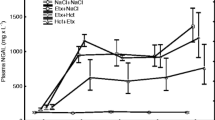Abstract
A neutrophil-derived relaxing factor (NDRF) from oyster glycogen (OG)-elicited rat PMN, which causes an endothelium independent relaxation of rat aorta, and which is pharmacologically indistinguishable from endothelium-derived relaxing factor (EDRF) has been described [1]. Experiments were designed to evaluate the presence of NDRF in PMN from rat-whole blood,-carrageenan pleurisy.,-OG peritonitis, and guinea pig (GP)-OG peritonitis, as well as in OG-elicited rat macrophages (MØ). Significant vascular relaxing activity was found using rat PMN from OG peritonitis and carrageenen pleurisy, as well as from OG-MØ. Little or no activity was found in rat whole blood PMN or PMN from GO-OG peritonitis. These results suggest that NDRF activity may be expressed upon cellular migration to an inflammatory site in the rat, and may not be present in all species. Also, all inflammatory cells examined were capable of reversing EDRF-dependent relaxations when stimulated to produce superoxide anion suggesting a dual regulatory role for these cells on local vascular tone.
Similar content being viewed by others
References
T. J. Rimele, R. J. Sturm, L. M. Adams, D. E. Henry, R. J. Heaslip, B. M. Weichman and D. Grimes,Interaction of neutrophils with vascular smooth muscle: Identification of a neutrophil-derived relaxing factor. J. Pharmacol. Exp. Ther.245, 102–111 (1988).
R. F. Furchgott,Studies on relaxation of rabbit aorta by sodium nitrite: The basis for the proposal that the acid-activatable inhibitory factor from bovine retractor penis is inorganic nitrite and the endothelium-derived relaxing factor is nitric oxide. InVasodilation, Vascular Smooth Muscle, Peptides, Autonomic Nerves, and Endothelium (Ed. P. M. Vanhoutte) pp 401–414, Raven Press, New York 1988.
W. Martin, J. A. Smith, M. J. Lewis and A. H. Henderson,Evidence that inhibitory factor extracted from bovine retractor penis is nitrite, whose acid-activated derivative is stabilized nitric oxide. Br. J. Pharmacol.93, 579–586 (1988).
R. M. J. Palmer, A. G. Ferrige and S. Moncada,Nitric oxide release accounts for the biological activity of endotheliumderived relaxing factor. Nature327, 524–526 (1987).
R. Iyengar, D. J. Stuehr and M. A. Marletta,Macrophage synthesis of nitrite, nitrate, and N-nitrosamines: precursors and role of the respiratory burst. Proc. Natl. Acad. Sci. U.S.A.84, 6369–6373 (1987).
A. Boyum,Isolation of mononuclear cells and granulocytes from human blood. Scand. J. Clin. Lab. Invest.21 (suppl. 97), 77–89 (1968).
J. W. Berkenkopf and B. M. Weichman,Different effects of antiinflammatory drugs on fluid accumulation and cellular infiltration in reverse passive arthus pleurisy and carrageenan pleurisy in rats. Pharmacology34, 309–325 (1987).
T. Matsubara and M. Ziff,Superoxide anion release by human endothelial cells: Synergism between a phorbol ester and a calcium ionophore. J. Cell. Physiol.127, 207–210 (1986).
Author information
Authors and Affiliations
Rights and permissions
About this article
Cite this article
Sturm, R.J., Holloway, D.A., Buckley, S. et al. Potential regulatory role of inflammatory cells on local vascular smooth muscle tone. Agents and Actions 27, 414–417 (1989). https://doi.org/10.1007/BF01972838
Issue Date:
DOI: https://doi.org/10.1007/BF01972838




